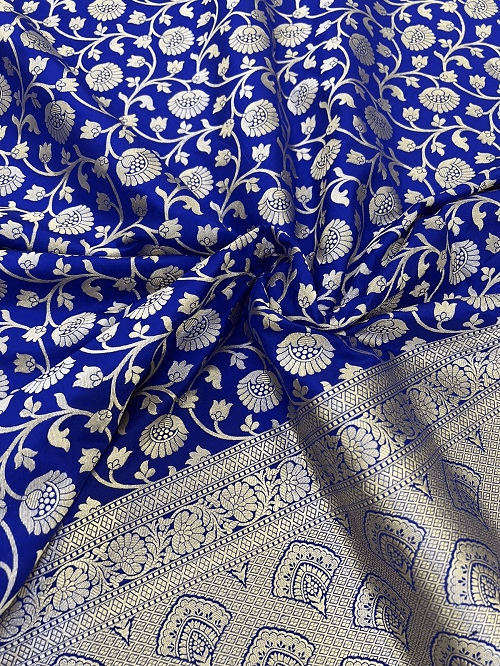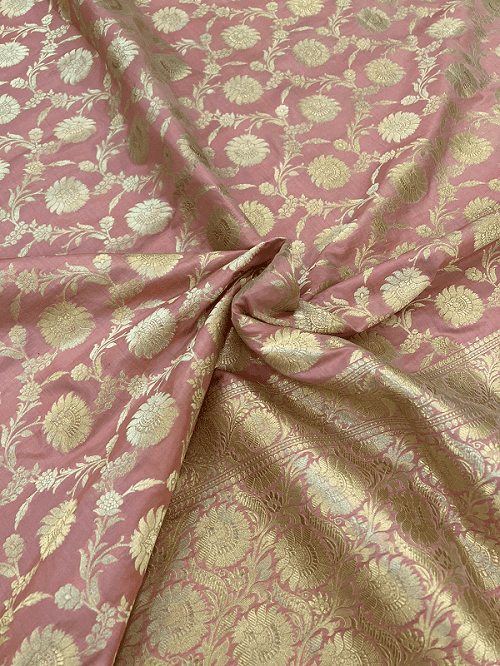A handloom banarasi silk saree is designed using pure silk, usually katan, to get a splendid look. This is one of the highest-selling sarees in India and their excitement and lushness fascinate every woman equally. Its splendor and grandness are matchless. Generally, it takes about 15 days to 6 months to make a single piece.
[Know Why Are Banarasi Sarees So Popular And Always In Demand In India?]
A banarasi handloom weaving silk saree is one apparel that every woman should have in her wardrobe. The charm, grace and exquisiteness that is imitated in a Banarasi saree emanate great hard labor and devotion that is used during the manufacturing process. All the steps are detailed and distinctly employed to give a Banarasi saree its majestic grandeur.
Types of Banarasi Silk Sarees
3. Tanchoi
4. Cut Work Saree
5. Shikargarh
9. Butidar
10. Shattir
11. Banarasi Silk Shalu
Everything about the Manufacturing Process
1. Graph Making

Graph is a complete design pattern of a saree comprising the border design, design of the pallu and buttis. This pattern is intended with the expertise of a graphic designer and reflects all designs within a little detail for giving precise construction and made to the last creation. All designs and patterns after getting approval at this step, enter the manufacturing and weaving process.
2. Cardboard/Patta Preparation
Patta refers to a template that is placed into the handloom mechanism to get the specific design on the cloth. On the basis of the graph intended, the patta is cut later on and some holes are punched for making the accurate pattern while the graph suggests. The patta is later on put into the mechanism. There are four distinct machinery types employed relying on the design for the weaving procedure to begin.
3. Thana/Silk Threads Processing
The process of the preparation of the silk yarn for weaving is called Karahi. During this process, the yarns are chosen to dispatch for Karahi that is the procedure of polishing and finishing the fabric before it enters the weaving and manufacturing process. During the stage, the yarns are formed to be ready for at least 4 to 6 sarees.
4. Dyeing

After the silk threads are prepared, the yarn goes through the dyeing process according to the necessities of the shades and patterns needed. All the shades and colours are selected precisely for making all sarees vibrant, matchless, and nice-looking.
[Know What Are Trendy Color Combinations in Banarasi Saree?]
5. Preparing the Bana
What is Bana? This is basically the tools integrated within the weaving machine. The step of bana preparation involves the making of bana for making it fit for the saree’s design. The weft and warp are made according to the detailing and design of the saree.
6. Selecting the right Zari
Zari enhances the elegance and charm of the pure handloom banarasi saree. It is actually the rustic, gold thread. It makes the saree appear heavenly by giving it some more elegance and too giving it a weighty look. Roopa, Antique, and Sona are the types of Zari that exist. These can be utilized during the process of weaving. This golden thread plays an important part in determining the whole look of the saree. In general, copper tested zari is employed in a majority of cases. But, gold and silver zari are too employed sometimes when preparing banarasi silk sarees for making them look more precious.
7. Sample Preparation
Once every detail is decided along with the designs, patterns and shades, a sample of size 2 to 3 inches is made for comprehending the concluding output. This is extremely vital in deciding the complete look of the piece and if it will suit the wearer or not. It does nothing but gives a hint of how the final output will be. It even aids in fixing errors and making any changes if necessary. As soon as the sample is accepted, the concluding output of the saree begins.
8. Weaving
Once the approval is attained, the weaving process starts. Weaving the first piece of a fresh design is not really easy for a weaver. They have the pressure of getting everything done accurately and for the final production to come out as per the expectations. An expert weaver who is well-experienced can get things done accurately.
9. Finishing
Once we are through with the weaving part, the piece undergoes processing for finishing. Any loose or extra threads are finished without any mistakes for making the saree all set for sale.
A silk kadhwa saree does not need to undergo the finishing process. Also, the cut work sarees are delivered to various finishing levels.
10. Final check of the piece
The last step incorporates the final check of the piece. This is basically done for ensuring that everything is perfect and the piece is all fit to put on sale.
[Read about The Expansion Of Banarasi Saree Over The Years]
Summing Up
For several years, Banarasi silk sarees have been worn at various special events and celebrations. They are among the most preferred attire among brides due to their majestic look. Also, they go very well with the occasions and happy moments. Albeli Fashion is a well-known brand that has also been in banarasi silk saree manufacturing for several years. One can contact us to buy banarasi sarees at factory prices in Varanasi.



.webp)


Comments
Leave A Comment: